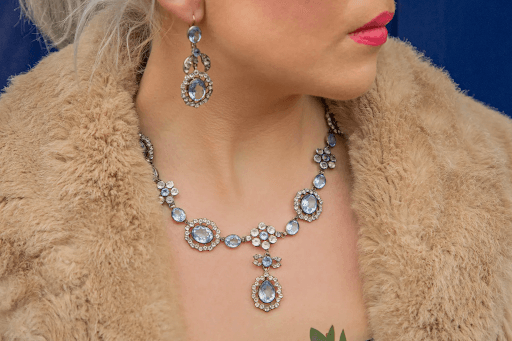Beauty
A Buyer’s Guide to Georgian Jewellery

Georgian jewellery is sometimes ignored in the midst of more popular eras like the Victorian, Art Deco, and Edwardian. In any case, the Georgian era is a fascinating one, and its jewellery exhibits the extraordinary skill and craftsmanship for which it is renowned.
Table of Contents
In What Period Of Time Is The Georgian Era Of Jewellery?
In spite of the fact that historians disagree about exactly which monarchs were in power during the Georgian era, the broad view is that it included the reigns of George I through IV. King William IV reigned from 1714 until his untimely demise in 1837, at which point the Victorian era began.
What Distinguishes Georgian Design?
Handcrafted luxury is the hallmark of Georgian design. The reign of the Hanoverian kings served as a major source of style inspiration throughout this time period, although there are other features from France and Germany present. Additionally, Georgian styles spread to the United States, drawing on American freedom as well as French Revolutionary-era inspiration.
Neoclassicism and romanticism can both be seen in Georgian design. All of this contributes to the richness, grandeur, and opulence that characterise Georgian style.
What To Look For When Purchasing Georgian Jewellery:
The most appealing aspect of Georgian jewellery is that each piece is one-of-a-kind. In spite of these differences, there are several characteristics that help distinguish Georgian jewellery. Jewellery made in the Georgian style often incorporates the following traditional methods:
Gemstones:
Gemstones like sapphires and rubies were prominent in Georgian jewellery, but pearls were also popular during this time period. Table or rose cuts are common for diamonds, whereas teardrop or cabochon cuts are common for sapphires and rubies.
Another distinctive element of Georgian jewellery is the use of closed-back settings or foil-backing on gemstones to enhance their radiance and scintillation.
Materials:
The use of 18ct gold in Georgian jewellery is popular. Even though silver was frequently used, gold was the preferred metal for Georgian jewellery, which is why 18ct gold is the most common. A lack of industrialization at the time meant that the materials used in jewellery were managed by hand, and gold was frequently hammered by hand to attain the appropriate finish.
Also, Check – How to Make Applying Skincare More Fun
Metalwork:
Handcrafted Georgian jewellery features a wide variety of metalworking techniques. During the Georgian era, jewellery was given a dramatic makeover by incorporating metallurgical methods such as;
Cannetille is a technique for creating a woven, lace, or spiral effect by twisting metals.
Using hammering on the reverse side to imprint or create a raised impression for a 3D texture look, repoussé is another common technique.
Georgian Jewellery Design Concepts:
Excavations at Pompeii and Egyptian artefacts discovered during the Georgian era are two notable examples. It was usual to see Roman-inspired motifs like grape leaves, keyholes, and laurel, as well as Egyptian-inspired papyrus leaves, in fashion designs.
Styles like Rococo, ornate, and lavish were fashionable, as were themes like feather plumes, ribbons, and bows. Georgian jewellery was frequently decorated with flowers, greenery, and leaves.
Jewellery From The Georgian Empire:
Genuine Georgian jewellery can be difficult to come by because of its age and the fact that it was made using highly sought-after materials and gemstones.
In Georgian times, chokers and dog collars were popular for necklaces because of their high necklines. Individually mounted gemstones connected together to form a strand of jewels have always been and continue to be popular.
Customizable and interchangeable, parure jewellery included necklaces, bracelets, brooches, and even earrings, all of which could be worn as a necklace or an earring. Jewelry owners were given a wide range of possibilities to choose from thanks to this new technology. It is becoming difficult to find a complete set of vintage jewellery, but individual pieces are still sought up by collectors.
Wearers of chatelaines could attach a variety of embellishments to the belts they wore, making them both beautiful and functional. Even writing implements like pens and pencils could be stored in the chatelaine. Because ornate elements from chatelaines were generally removed and reimagined as pendants, it is uncommon to locate a whole chatelaine.For more antique jewellery check out Susannah Lovis London.

-

 Business3 years ago
Business3 years agoHow to Do Long-Distance Moves with Children
-

 Travel2 years ago
Travel2 years agoQuick Guide: Moving To Santa Rosa?
-

 Real Estate3 years ago
Real Estate3 years agoWhy Dubai Festival City is a Great Neighbourhood for Young Learners
-

 Business3 years ago
Business3 years agoIs Guest Posting a Good Inbound Marketing Strategy?
-

 Business1 year ago
Business1 year agoThe Ultimate Guide To Thriving In Your Printing Franchise
-

 Business1 year ago
Business1 year agoExploring The Benefits And Challenges Of Restaurant Franchising
-

 Tech3 years ago
Tech3 years agoCyber Table That Will Change Your Life
-

 Lifestyle1 year ago
Lifestyle1 year agoDallas’ Hidden Gems: 6 Must-Try Restaurants Off The Beaten Path!









Recent Comments